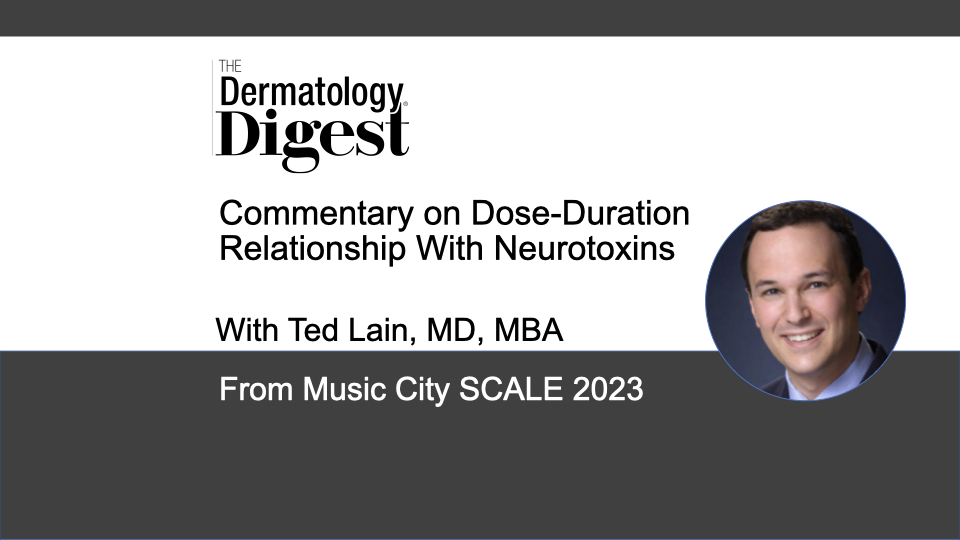Dr. Ted Lain discusses dose duration among neurotoxins, including efficacy, endpoints, and patient expectations.
Ted Lain, MD, MBA, board-certified dermatologist and Chief Medical Officer, Sanova Dermatology, Austin, Texas.
“The genesis of the talk came from my involvement as an investigator in the Botox (onabotulinum toxin) dose escalation trial. We looked at 20 units in the glabella versus 40, 60, and 80 units,” said Ted Lain, MD, MBA, who presented “Dose-Duration Relationship with Neurotoxins” at Music City SCALE 2023.
“And what we found is that the 40-unit dose …is the ‘winner’ in terms of giving the best efficacy and longest duration, but also with the best patient satisfaction.”
This led to thinking about other toxins and an examination of the data available from other dose escalation trials, said Dr. Lain.
“Obviously, we have Daxxify, or daxibotulinum toxin available. That data is available from their phase 3 [trial], but they also did a phase 2 trial where they compared 20 units of daxibotulinum toxin to 20 units of onabotulinum toxin.”
At the 20-unit dose, both toxins showed similar duration, said Dr. Lain.
“But when you go to 40 units of daxibotulinum toxin in the glabella…. you see a longer duration in their trial versus the 40 units in the onabotulinum toxin trial and that may be related to the RTP004 peptide attached to the 150kDa toxin. RTP004 has a net positive charge allowing it to strongly bind to the net negative charge of the neuronal surface. Theoretically this localizes a high concentration of the toxin to the presynaptic terminal.”
“And then you look at abobotulinum toxin, which is Dysport. And they did a nice trial where they compare their 50 units on label in the glabella versus 75 and 125.”
According to Dr. Lain, both the 75- and 125-unit doses showed longer dose duration but the 125-unit dose wasn’t much longer.
“75 units give a good six-month response in terms of return to baseline, which is really compelling especially considering a cost-benefit analysis.”
Examining Endpoints
Of course, since there are no head-to-head trials, any data comparison must be assessed with some skepticism, said Dr. Lain.
“While the panels of investigators in these dose-escalation trials are largely similar, patient populations, inclusion/exclusion criteria, and endpoints differed.”
Indeed, endpoints, and the language around success, need to be understood in order to interpret results of these trials, he said.
“I think the most clinically meaningful endpoint is the time to loss of none or mild.”
In other words, how long it takes for patients to maintain no or mild wrinkles in the treatment area, he said.
“Most of the patients were moderate to severe at max frown in their glabella at baseline in terms of the facial wrinkles scale. Duration of a one-point improvement is also a common endpoint, as well as time to return to baseline.”
According to Dr. Lain, the “median six-month duration” often is a return to baseline, not time to mild or moderate wrinkling, which may not be as clinically meaningful.
“So then we looked at the incobotulinum toxin… They really bumped up the dose and they had no placebo arm in their trial either.”
Dosing was compared at 20 units, 50 units, and 75 units.1
“It’s a little bit more difficult to interpret that data without a placebo arm. But they show a dose response curve with that’s surprisingly long as well, quite frankly, with the 50-unit dose which, again, is more than double what their FDA approved dose is.”
“Again, no head-to-head trials at these doses, but just comparing the data and see what doses they chose [and] what endpoints they chose to… think about how to prolong the duration for our patients.”
Daxibotulinum toxin has started the conversation about longer duration with toxins and part of that is addressing the concept of median duration, said Dr. Lain.
“Six months is right in the middle, which means half the patients get less than that; half the patients get more than that.”
This is an important conversation because you can’t guarantee six months for patients regardless of toxin, said Dr. Lain.
“Some patients are on board with a longer duration and they want to do a higher dose because they want to decrease the number of visits.”
But many of his patients still prefer their regular treatment schedule, he said.
“They want to make sure they come in every three or four months because they don’t want to lose efficacy at all. And they’re just so used to doing that cadence that it’s hard for them to break that pattern.”
More frequent patient office visits can also be better for the practice because of the opportunity to discuss other products or procedures, he said.
“I think that while it has started that conversation, I haven’t seen the conversion to every six months that I thought I would see in my in my toxin patients. But maybe it just takes some time for that to mature in the market.”
References:
- Kerscher M, Fabi S, Fischer T, et al. IncobotulinumtoxinA Demonstrates Safety and Prolonged Duration of Effect in a Dose-Ranging Study for Glabellar Lines. J Drugs Dermatol. 2020 Oct 1;19(10):985-991. doi: 10.36849/JDD.2020.5454. PMID: 33026771.
- Joseph JH, Maas C, Palm MD, et al. Safety, Pharmacodynamic Response, and Treatment Satisfaction With OnabotulinumtoxinA 40 U, 60 U, and 80 U in Subjects With Moderate to Severe Dynamic Glabellar Lines. Aesthet Surg J. 2022 Oct 13;42(11):1318-1327. doi: 10.1093/asj/sjac157. PMID: 35704394; PMCID: PMC9558451.
- Joseph J, Moradi A, Lorenc ZP, et al. AbobotulinumtoxinA for the Treatment of Moderate-to-Severe Glabellar Lines: A Randomized, Dose-Escalating, Double-Blind Study. J Drugs Dermatol. 2021 Sep 1;20(9):980-987. doi: 10.36849/jdd.6263. PMID: 34491016.
- Carruthers JD, Fagien S, Joseph JH, et al. DaxibotulinumtoxinA for Injection for the Treatment of Glabellar Lines: Results from Each of Two Multicenter, Randomized, Double-Blind, Placebo-Controlled, Phase 3 Studies (SAKURA 1 and SAKURA 2). Plast Reconstr Surg. 2020 Jan;145(1):45-58. doi: 10.1097/PRS.0000000000006327. PMID: 31609882; PMCID: PMC6940025.


